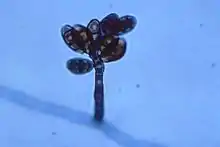Curvularia
Curvularia is a hyphomycete (mold) fungus which is a facultative pathogen, or beneficial partner of many plant species and common in soil.[1] Most Curvularia are found in tropical regions, though a few are found in temperate zones.
| Curvularia | |
|---|---|
 | |
| Curvularia geniculata | |
| Scientific classification | |
| Kingdom: | Fungi |
| Division: | Ascomycota |
| Class: | Dothideomycetes |
| Order: | Pleosporales |
| Family: | Pleosporaceae |
| Genus: | Curvularia Boedijn, 1933 |
| Type species | |
| Curvularia lunata (Wakker) Boedijn | |
Curvularia defined by the type species C. lunata (Wakker) Boedijn. Curvularia lunata appears as shiny velvety-black, fluffy growth on the colony surface. C. lunata is distinguished by septate, dematiaceous hyphae producing brown, geniculate conidiophores. The poroconidia are curved slightly to distinctly, transversely septate, with an expanded third cell from the pore end of the conidium. Curvularia can be easily distinguished from Bipolaris and Drechslera spp. since the conidia are non-distoseptate, that is, septate from edge to edge of the conidial wall. The teleomorphic state of the type species Curvularia lunata is Cochliobolus lunatus (Fam. Pleosporaceae, Ord. Pleosporales, Cla. Loculoascomycetes, Phy. Ascomycota).
Heat-tolerance symbiote
Curvularia protuberata is an endosymbiote of the panic grass Dichanthelium lanuginosum that enables it to thrive near hot springs in soil temperatures of up to 104 °F (40 °C). The fungus confers this protective effect only when itself infected by the Curvularia thermal tolerance virus (CThTV). Plants unrelated to panic grass also experience this protective effect when inoculated with the virus-infected fungus.[2]
Species

Primary species of Curvularia commonly found in soils and on plant tissues (including seeds):
- C. affinis
- C. brachyspora
- C. caricae-papayae
- C. clavata
- C. eragrostidis (Cochliobolus eragrostidis (Teleomorph))
- C. fallax
- C. geniculata (Cochliobolus geniculatus (Teleomorph))
- C. harveyi
- C. inaequalis
- C. lunata (Cochliobolus lunatus (Teleomorph))
- C. ovoidea
- C. pallescens
- C. penniseti
- C. prasadii
- C. protuberata
- C. senegalensis
- C. trifolii
- C. tuberculata (Cochliobolus tuberculatus (Teleomorph))
References
- Priyadharsini, Perumalsamy; Muthukumar, Thangavelu (2017-06-01). "The root endophytic fungus Curvularia geniculata from Parthenium hysterophorus roots improves plant growth through phosphate solubilization and phytohormone production". Fungal Ecology. 27: 69–77. doi:10.1016/j.funeco.2017.02.007. ISSN 1754-5048.
- reference to Redman, Rodriguez, and Henson experiment
External links
- "Curvularia (black kernel)". Centre for Agriculture and Bioscience International Invasive Species Compendium. 2019-11-21. Retrieved 2020-11-25.